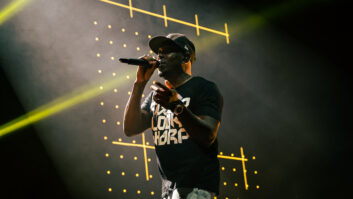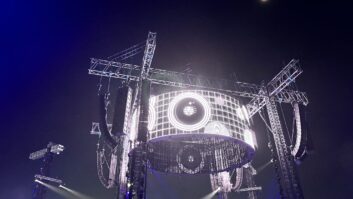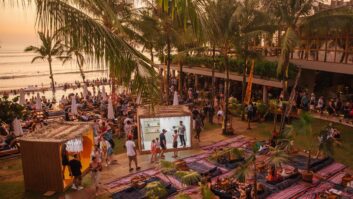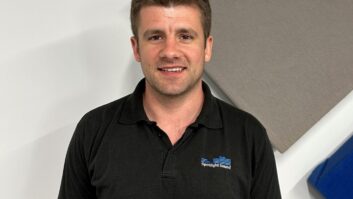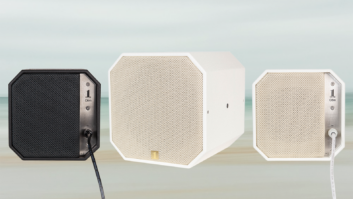
What you got from Prolight + Sound 2010 seemed to depend on whether you chose to be optimistic or pessimistic. Pessimists might point to the wider aisles (with insufficient carpet in at least one hall), the unfilled space at the back of some halls, a repetition of many products launched at ISE a few weeks earlier and, for some exhibitors, an apparent reduction in the geographical diversity of the visitors.
Optimists, however, would talk about the generally positive mood of the show, numerous announcements about technical collaborations and distribution agreements as well as new products, and show attendance numbers that, taken in conjunction with the adjacent (and much larger) Musikmesse, indicated only a slight decline on visitor numbers compared with last year, despite the downturn. And, on a purely selfish note the concentration of audio companies in Hall 8 made for much less walking back and forth between distant halls!
We don’t have space for a fully comprehensive review of everything we saw, but here are the most significant products and announcements.
Loudspeakers
Perhaps the quirkiest product on show – albeit in a prototype form – was on the Yamaha stand. The TLF speaker – it stands for Thin Light Flexible – is a speaker around 1mm thick that can be rolled up like a poster. It can be covered in a fabric that can be printed on, or potentially used as a projection surface.
The speaker produces a remarkably directional sound: two were placed side by side on the stand, linked to different speech outputs. As you stood in front of either one, you could not hear the output from the other. The sound is not hi-fi quality, but it’s perfectly acceptable for speech.
The expected price for the TLF speaker at A0 size is 300-400 euro, including the dedicated amplifier. The maximum SPL for this size is 96dB at 1m.
The largest that has been made so far is 5m x 1m, although Yamaha states that other sizes are possible according to customer requests. The TLF can be rolled to a minimum radius of 10cm for audio, or 5cm for transport.
Yamaha was demonstrating the prototype to gain feedback from potential users, but there are clear possibilities for the TLF in areas such as museums, education, retail and possibly advertising.
Having announced that it is bringing its pro-ribbon technology to the touring and larger installation markets, Alcons Audio chose ProLight + Sound to premiere the LR24 system.
“We feel that the time has come to turn three years of research into a new range of Alcons solutions,” said Alcons managing director Tom Back. “Hi-fi quality sound at concert SPLs has always been the Holy Grail of sound reinforcement. Now it is finally available and it marks the next step in the position of Alcons in the pro-audio market.”
The Alcons LR24 system is designed to be able to deliver the same SPL of equivalent products in the mid-size line-array category, but with 15dB less distortion. It is a complete package, comprising line-array, line-array bass, ground-stacked subs, multi-channel amplification and processing. The amount of new development work that has been entailed is reflected in the fact that the system has given rise to three pending patents.
Steerable audio pioneer Duran Audio was presenting its latest development – AXYS beam-shaping subwoofers. Being able to steer the dispersion from bass arrays will be attractive at large outdoor events, where noise pollution into neighbouring areas can create problems. However, Duran is also aiming the product at theatres, concrt halls and conferences. “You can add more definition and punch to the low end and banish that flabby undefined bass sound that you normally experience due to the poor the direct to reverberant ratio at low frequencies,” said managing director Nick Screen.
Consoles
In the audio console world, the trend towards producing products with an ever-smaller footprint continued. Soundcraft launched the Vi1, which has 16 motorised channel faders and uses the same Vistonics interface as its larger siblings the Vi6 and Vi4 and, says Soundcraft, offers the same sound quality.
One might have thought, from the product numbering, that that was the end Soundcraft’s plans for making consoles smaller. However, hailing “the start of a new age of a new type of console,” VP marketing Keith Watson presented a glimpse of the forthcoming Si Compact.
DiGiCo, which has been producing new consoles at a prodigious rate for the past couple of years, continued with the compact SD9, aimed at (on the install side) applications such as schools, conference centres, smaller theatres and houses of worship. The SD9 includes a mixing surface with 24 full-length motorised faders, D-Rack digital stage interface and Cat5e digital multicore. The D-Rack, which is floor or rack-mountable features 32 microphone inputs, eight line outputs and eight modular (AES/analogue) outputs – but this capacity can be doubled by the addition of a second D-Rack.
Familiar DiGiCo features such as Stealth Digital Processing software with its FPGA technology mean that, according to the company, “productions on a budget will now be able to utilise audio quality and flexibility that is on a par with the highest level of productions that use DiGiCo SD7, SD8 and D series consoles.”
For some observers, the DiGiCo SD9’s red livery brought to mind another mixer company, Allen & Heath. Also following the “smaller is beautiful” trend, A&H launched two new models to the iLive digital mixing series: the iDR-16 3U MixRack and iLive-R72 rackmountable control surface. With these additions, the iLive Series now includes a total of six surface and five MixRack variants, which can be mixed and matched in any combination.
The company also announced that it is collaborating with Audinate to introduce Dante networking modules for the iLive series. Dante will be incorporated into Allen & Heath’s range of audio networking plug-in cards. “With the growing rate of adoption of Audinate’s Dante networking in other AV products, we felt the timing was right to add this to our iLive series,” commented Glenn Rogers, managing director of Allen & Heath.
Cadac showed its S-Digital theatre and live production console system in final production form. Described by its maker as “Cadac’s most significant product development since the launch of the industry standard J-Type in 1992,” the S-Digital is designed to combine the audio character, tools, features and surface architecture of the J-Type, with the operational capabilities of digital consoles yet designed. Features include hot swappable input and output modules, embedded signal processing, dedicated show automation software, and full redundancy backups on power supplies, inter-system communications, audio path and control.
Networking
With audio-video bridging over Ethernet (AVB) the focus of much attention currently, an operating system for AVB networks was presented by UMAN – a young company that was only founded in 2007. UNOS is a platform- and network-independent operating system that promises “swift, risk free integration” of audio, video and lighting devices into AVB networks.
There are three parts to the UNOS offering. UNOS core is a set of hardware drivers and middleware for manufacturers to include in their products to provide the low-level communication. UNOS creator is a tool for the straightforward creation of user interfaces by means of drag-and-drop, rather than by writing code. And for end-users, UNOS vision is a freeware browser that displays manufacturer-specific GUIs.
One of the first manufacturers to incorporate UNOS is CAMCO. Its new V8 amplifier, launched at the show, makes use of the UNOS system. “It’s not complicated – you just join elements and they are working together,” said Camco managing director Reiner Sassmann. “You can design functionalities wherever you want them. I strongly believe that this is the future of user interfaces.”
The V8 is a high-performance Class H amplifer, delivering 8800W in either 2 ohm or 4 ohm mode. Unusually, it has no control knobs or switches on the front or back: the control of all parameters is via screen display and gain sliders. This reduces wear and tear factors on moving parts, as well as “developing a more progressive approach to function and form,” according to the company.
“The new V8 is much beefier than its distinguished stablemate the Vortex 6, because the industry across-the-board is asking for more power from its amplifiers,” said Mick Anderson, CAMCO international sales director.
Amplifiers
On the subject of power amps, Lab.gruppen unveiled the new flagship model for its PLM series. The PLM 20000Q integrates two full-featured modules of Lake Processing with four channels of power amplification, each rated at 5000W output. According to Lab.gruppen, this output capacity makes the PLM 20000Q “easily the most powerful four-channel amplifier solution on the market”.
Frankfurt was the location for the European debut of Crest Audio’s E-Lite power amplifiers. These are lightweight, efficient products offering high power and stable performance down to 2-ohm loads.
Crest Audio E-Lite Series amps use a Class D design with a switch-mode power supply that reduces weight while increasing reliability, thermal efficiency and output power. The E-Lite 1800 and E-Lite 1800 DSP boast 900 watts per channel and weigh less than 4.5kg. The E-Lite 1800 DSP (shown here by Crest’s Kevin Ivey) features an onboard digital signal processor that hosts a suite of delays, adjustable crossover, adjustable limiter, parametric EQ, HF driver EQ, four user preset storage locations, and stereo/mono operation with lockable security settings.
MC2 Audio previewed its first four-channel Class D switch mode amplifier. Full details have yet to be issued for the latest addition to the E series, the E100, but it is expected to offer a specification of circa 3,200W per channel at 4 ohms or 2,500W per channel at 2 ohms.
Other audio
If you had been wondering why APart issued a flurry of new products in 2009 but a rather more limited number so far this year, the answer was revealed in Frankfurt. Seeking to extend its reach to installers with little experience of audio – such as installers of lighting or security systems – the company has produced a brochure-cum-installation guide entitled PlugNPlay: Essential Audio Applications. “The basic message is, you don’t have to be afraid of professional audio,” explained marketing manager Filip van Eetvelde.
The guide outlines typical installations for 39 environments – such as shops, boardrooms, bars, auditoriums and so on – of different sizes. It specifies the products required for these installations, and provides a full kit list, including cabling. At the front of the guide is an FAQ section which outlines the fundamentals of audio installation, drawing parallels where appropriate with other electrical work, such as lighting. The full APart range – which needed to be complete before the guide could be published – is detailed at the back.
The guide is currently available in English and German, and a total of 10 languages are planned.
Also looking to educate a wider audience was QSC, which has produced a DVD entitled Understanding Sound Reinforcement: The Learner’s Guide. Aimed at those who may be working with audio for the first time – such as sound engineers, musician, DJs or end-users within schools, community organisations, businesses and the like – the DVD consists of ten chapters covering subjects such as signal path and gain structure, acoustics, microphones and loudspeakers.
QSC also took the opportunity to launch the KW series of portable powered loudspeakers. This builds on the K series, launched at the same show last year, but uses a wood enclosure rather than moulded ABS.
With the EN54 legislation for voice alarm systems coming into effect in March 2011, the pressure is on manufacturers to produce compliant equipment. TOA presented its new products that meet EN-54 standards include the VM-3000 series PA/VA system, combining digital audio PA, paging and BGM functionality, the PC-1867 FC 12-cm flush ceiling mounted speakers and BS-680FC public address speakers.
“We expect the new standard to change the voice alarm industry, what equipment you can use and how voice alarm systems are installed,” said Brett Downing, sales & marketing director at TOA Europe. “We believe we’re the first company to have EN54 part 16 certification for a complete voice alarm system.”
Neutrik showcased a new solution to cope with the challenges of the forthcoming spectrum changes. The new DIWA (digital wireless audio) technology promises data transmission without data compression, using the 5GHz frequency band. The first product to employ the technology, the Xirium professional multi-channel wireless system, includes a four-channel basis unit, mobile send and receiving units. An extension unit allows the system to be extended to eight channels.
Lighting
Barco announced a ‘cascade’ of creative lighting products and enhancements at Frankfurt. The new intellaspot XT-1 is a professional moving luminaire that is said to offer remarkable innovations in optics, lamp configurations, high lumen output, energy efficiency, zoom range, and overall feature set — all at a highly economical price point. According to Barco, “it’s designed to set a new benchmark in price and performance for mid-market customers.”
Also new at the show, the SDI-DMX Mixer Pro is a hybrid switcher that offers users the ability to switch, mix and matrix four video inputs to four video outputs — directly from any DMX lighting controller. “To ease and simplify the overall control task, the new SDI-DMX Mixer Pro places the power of video switching and crossfades directly into the lighting designer’s hands,” says the company.
Ray Laser Technologies’ new Nano laser range was presented in conjunction with Arcstream AV, its exclusive UK distributor. A range of OPS, full colour, laser systems between 10W and 42W, the flagship is the Nano Rainbow – the only OPS laser on the market with six individual wavelengths.
“We are using the smallest laser diode drivers available for high power laser diodes,” explained Karl Kaes, Ray Laser Technologies’ managing director. “This means easier handling due to smaller size and weight, higher efficiency and lowest heat dissipation. We have been working for the last year on creating this laser series which are brighter due to the technology used and offer an increased colour range for more creative options.” Safety features include circuitry current protection and an IP67 rating.
Centre stage on the Litestructures stand was the production version of its innovative LiteConsole performance platform. Originally developed as a custom product for DJ Paul Oakenfold, it is now available as a stock option in a customer-configurable format. It is a versatile podium structure that offers a portable and high-visual-impact solution for applications from corporate AV presentations, live musician and DJ performances and recording projects to trade shows and exhibitions. Standard modules are designed to house a 50in plasma screen, although this open space could also feature a backlit corporate logo, LED panels, starcloth, or any other form of corporate messaging.
Robe had no fewer than 11 new product launches in Frankfurt this year. The new ColorBeam 2500E AT is the most powerful moving head yet to be designed and produced by Robe. It is designed for large-scale applications where extremely powerful tight beam-effect fixtures are required. A multi-step zoom facility provides variable beam size from between 1.5 and 10 degrees. Rotating gobos and rotating prisms can be used to create spectacular mid-air effects and there is also full CMY/CTO.
In addition, the ROBIN Series of moving lights has been expanded with the addition of the 600 range and the Classic 300 range of value-conscious units.
AC Entertainment Technologies was demonstrating two new ranges for which it has exclusive distribution in the UK and Ireland. G-LEC’s range of low-resolution transparent LED video solutions includes the new Solaris+ display, which launched at the show. This features 40mm diameter ‘pixel spheres’ mounted at 120mm centres on flexible rope, to produce an eye-catching 360° hanging LED video curtain. Soon to launch is G-LEC’s Chimera LED installation video system. Comprised of LEDs mounted on printed circuit boards, the Chimera is the first ‘cut to fit’ product to offer absolute flexibility of shape without compromising control over individual LEDs.
AC-ET is also distributing the InnovaLED TP825 panel, an IP rated display solution that marks a new level of affordability in its product class. This 3200 nit, 25mm pitch LED module is the first in a range of models being developed by InnovaLED, a new European company formed by seasoned industry professionals.
